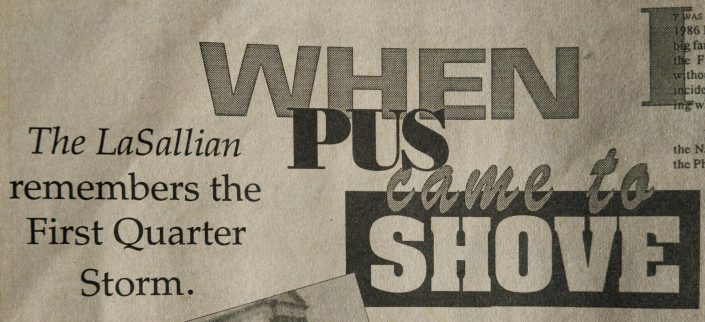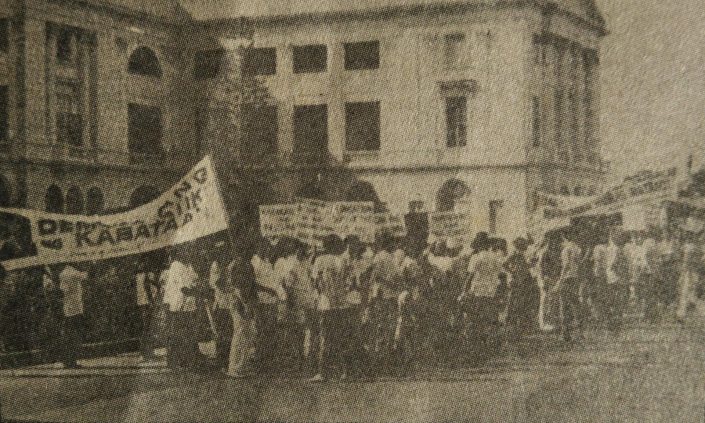
It was pandemonium back then. Come to think of it, the 1986 Edsa Revolution seemed to be nothing more than a big family picniccompared to the events that transpired in the First Quarter Storm of 1970. Having been born without the liberty of having first person accounts of these incidents, many of today’s youth never even bother thinking what the silver anniversary is about.
January 26, 1970
President Ferdinand Marcos delivered his State of the Nation Address at the opening of the first session of the Philippine Congress while a mass demonstration was simultaneously held outside the Congress Building “to expose the real state of the nation and to oppose the lies of the reactionaries.”
Fifty thousand demonstrators, composed of students, peasants, and militant workers, walked the streets and stood their ground, eventually coming face to face with at least 7,000 policemen who had no qualms about committing brutal crimes so long as they protected the so-called “fascist puppet government” of Marcos.
The protestors lamented the death of democracy and the suppression of the national freedom and constitutional rights of the people in their skirmish with the police. After the government troops eventually subdued the militant crowd, the demonstrators became even stronger and more unified to start another rally.
January 30-31, 1970
Again, more than 50,000 students, progressive intellectuals, peasants, and workers joined the mass demonstrations that attacked the government’s suppression of their rights, this time in front of the Malacanang Palace. But the government troops were not satisfied with their “not-so-bloody” attack a few days before that they wanted rifles to complement their clubs and tear gas bombs this time. Demonstrators fought back with explosives made on the spot, iron bars from steel railings, and stones. They even took control of a fire truck which they used to barge through Malacanang gates.
In fear of a revolution, the government placed the 12,000-man Philippine Constabulary on “red alert” and the air force, navy, and army on “blue alert.” By the early hours of January 31, four casualties were reported as a result of the gunfire. In addition, hundreds were injured and many more became maimed for life as the troops continued their truncheon beating on the crowd. In fact, right after the confrontation, hundreds of demonstrators were arrested, tortured, and interrogated for hours. The savage government forces even threw wounded demonstrators into PC trucks as if they were animals ready to be butchered.
It was a lot worse than the January 26 demonstration. Never has there been a more open and bloodier suppression of democratic rights in the city than the suppression of the demonstration of January 30-31.

Lasallians Who Led The Movement
One of the famous student leaders during that time was then Student Council President Leonardo “Chito” Sta. Romana, who was also one of the heads of the “progressive” movement National Union of Students (NUS) alongside UP student Fernando Barican. This group has somehow developed a working relationship with the studentry’s left wing sector. It was responsible for making the issue “rising fascism” a common ground between moderates and the radicals.
Probably the most prominent among the underground movement leaders, which was termed “UG” back then, was then Editor in Chief of The LaSallian Calixto Chikiamco. Students who were then active in the “UG” movement clearly know that he was the leader/coordinator of all the universities and colleges in the southern part of Greater Manila. It was even said that months before martial law was announced, he even represented the whole of the studentry in Metro Manila in the nationwide movement including the peasants and laborers, among others.
Historical Significance
These demonstrations that ended in bloody confrontations served only as a prelude to even bigger mass actions on a nationwide scale in the near future. The demonstrators succeeded in voicing out the “real” state of the nation, in which Marcos acted as a fascist puppet of U.S. imperialism.
Never before has the countryside revolutionary mass movement been as well joined by that in the city. These demonstrations have no doubt succeeded in exposing the basic rottenness of the entire system. Sad thing is, twenty five years later, the system still stinks.
EDITOR’S NOTE: The article, originally published in the February 1995 issue of The LaSallian, was titled “When pus (sic) came to shove.” To avoid confusion, the article is being reposted with the typo corrected.
